Stiff or bendy? Smooth or knobbly? Ratchets or laces? There are as many types of MTB shoe as there are types of MTB. Here’s how to pick what suits you best.
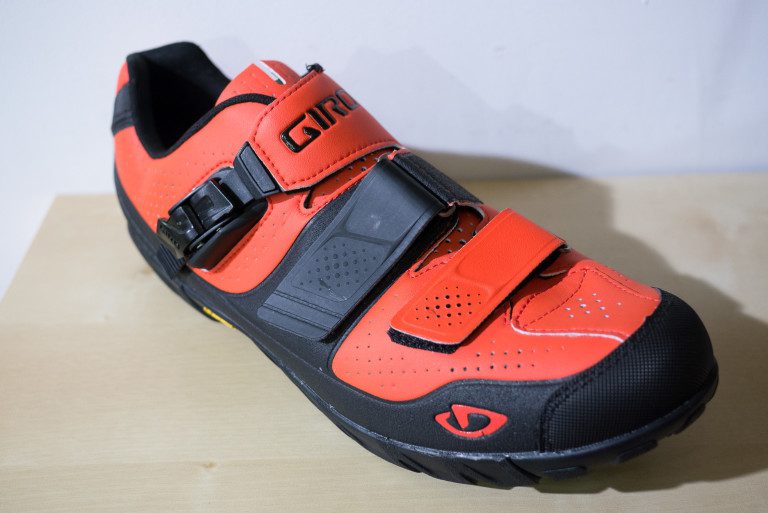
Unlike road cycling shoes, mountain bike shoes aren’t just about being stiff stiff stiff. MTB shoes are certainly stiffer than casual shoes but they aren’t so stiff as to make walking around in them an uncomfortable and sketchy experience. (Giro)
Most of this buyers guide is going to be based around MTB shoes that work with clipless pedals (aka SPDs). Despite the recent boom in flat pedals, the vast majority of regular mountain bikers are clipping into pedals with cleats on the soles of their shoes.
The range of MTB shoes available is vast. Much like MTB bikes, the correct choice depends on just what sort of riding you want to do.
There are super stiff carbon soled affairs with fancy uppers and complex looking ratchet closure systems. Pretty much like road shoes with a couple of token knobbles on the sole for off-bike walking (or running).
At the other end of the spectrum there are shoes that look almost like regular outdoorsy hiking footwear that just happen to have a recessed cleat underneath the sole.
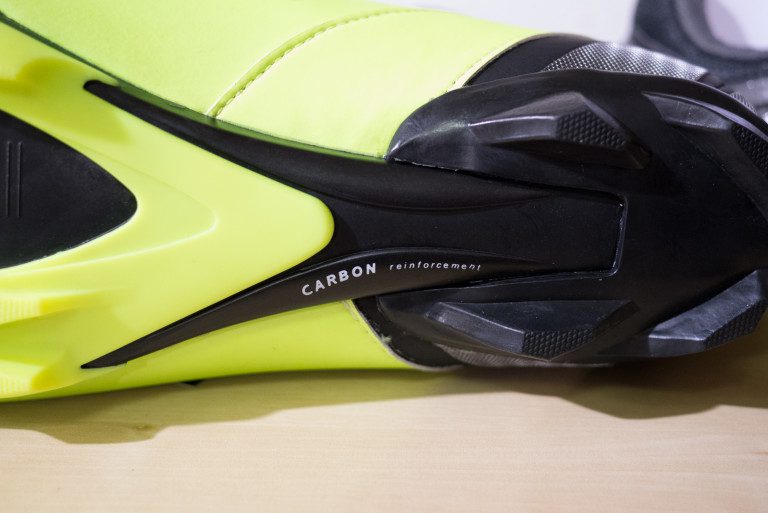
The bottom of the shoe
How stiff do you want it?
This is perhaps the main question. Stiff shoes are good for pedal power but they can be odd or uncomfortable when walking in them. If you prioritise pedalling over walking, then fair enough. Generally speaking, shoes with predominantly – or entirely – carbon fibre soles will be the stiffest.
Stiff soled shoes can actually be more comfortable than softer shoes if you’re using small bodied pedals. There’s less ‘hotspotting’ (pressure point of the pedal coming through the sole of the shoe and into your foot).
Some stiffness is a good thing for pretty much all MTBers really. Most MTB shoes have a reinforced sole under and around the ball of the foot and pedal area. This is both for pedal power and to reduce hotspotting. The stiff section usually ends before the toe area so that the shoe can bend there. This really helps make the shoe easy to walk in, especially when walking up steep slopes.
There are now some shoes that can be heat molded to better fit your foot shape. Sometimes this refers to the footbed, sometimes it refers to the upper material. This is a pretty niche feature but it’s one that a lot of XC racers really appreciate as it improves comfort without the bulk of thicker materials (or thick socks). It is possible to have stiff, light shoes that are extremely comfy as well as super efficient.
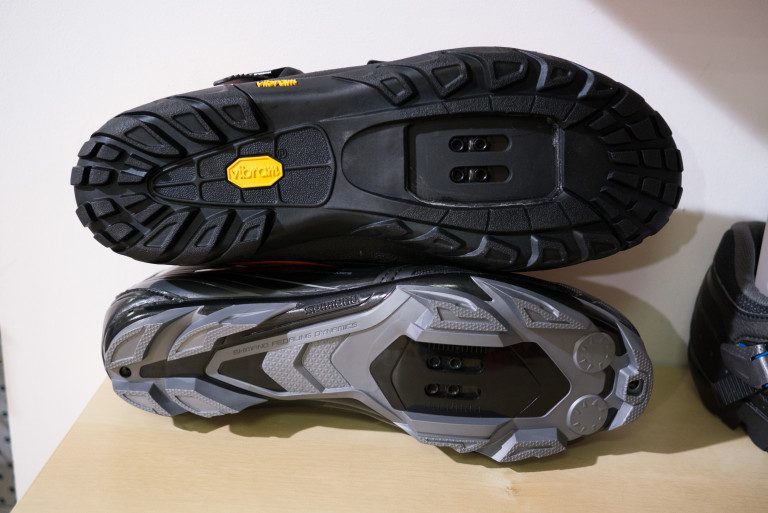
Sole tread design
The most popular type of MTB shoes has a built up set of knobbles and chunks encircling the cleat recess. This is paired with another grouping of knobbles right under the heel of the shoe.
Behind the ball of the foot and in front of the heel there’s often no tread present. This is because this area is fairly redundant in terms of walking traction so it’s a good place to remove bulk and weight.
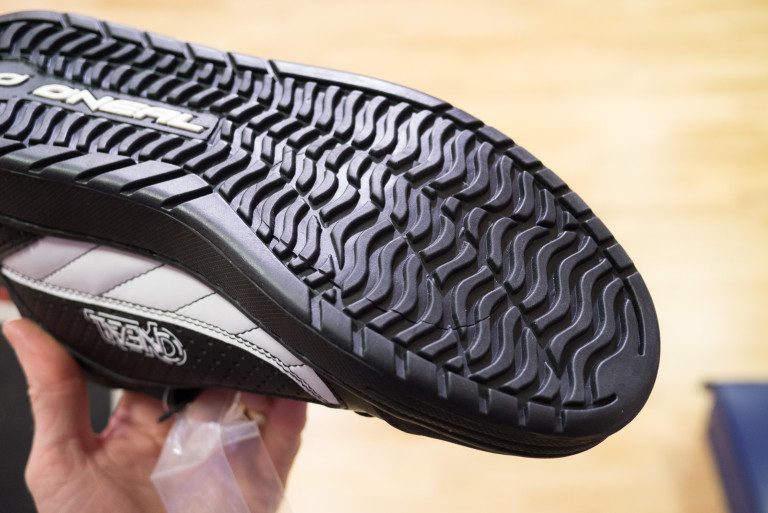
Some DH shoes have no knobbles or chunks on their soles. This is because those riders prefer to use big bodied/caged clipless pedals (for comfort, feel and security) and flat soled shoes mate better which such pedals. DH shoes are also softer and bendier, which again is to do with the sole-to-pedal interface feel.
The type of rubber or plastic used for the tread has an influence too. Harder, more plasticky knobbles will last longer but they will be slippery on roots and damp rock. Softer rubber knobbles will grip better on all surfaces but may be more susceptable to wear and damage.
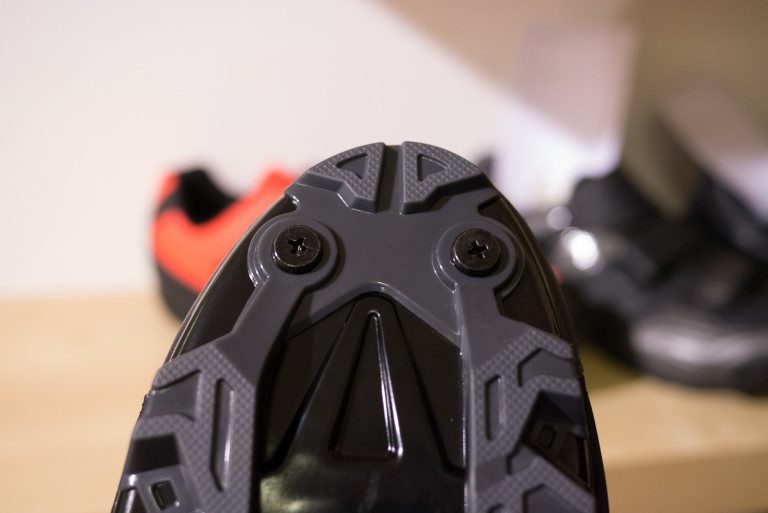
The front of the shoe
Stud capability and toe box protectection.
Some riders in winter find that having studs at the front of their shoes is very useful when floundering about in mud. This is becoming something of a less common feature on shoes these days so it’s best not to assume that all shoes have this capability. Check the description properly.
Reinforced toe box ‘bumpers’ are the other thing you find on MTB shoes up front. Oddly these seems to be more prevalent and more rigid on racier XC shoes than other types. As well as protecting your toes from whacks from rocks and stumps etc, toe box bumpers can also help with the fit, comfort and performance of the shoe overall.
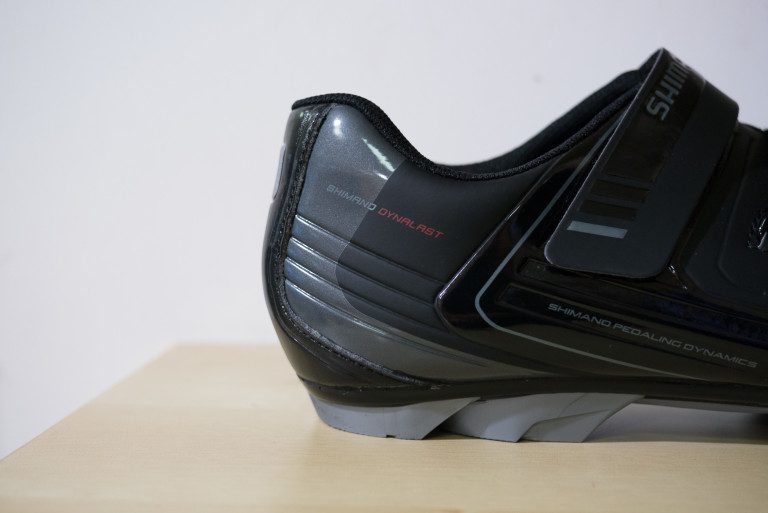
The back of the shoe
Having a shoe that stays in place is a good thing. Having a shoe that slips up and down your heel during pedaling or walking is not a good thing. It robs you of power, causes blisters and – when running up a steep slope – can even cause the shoe to come off your foot entirely.
Heel cup design is what a lot of cycling shoe designers spend their time on. Most shoes keep the heel in places by having a shaped cup back there. Some shoes have screw-adjustable pinch plates at the back (SiDi).
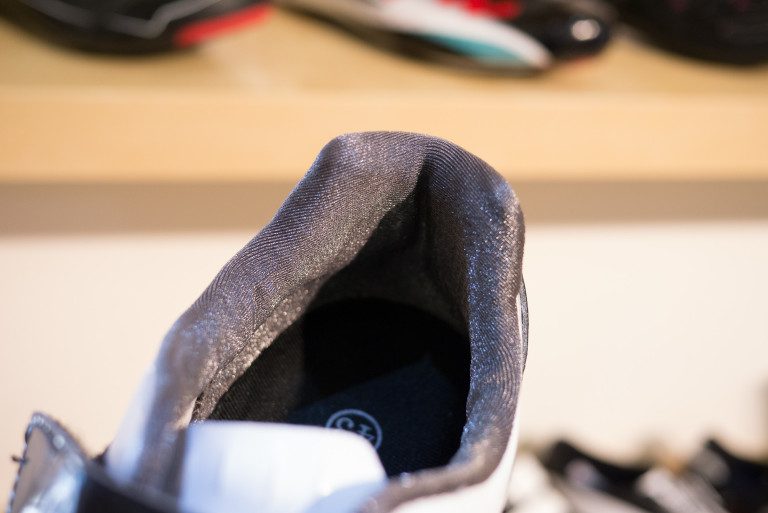
Other shoes use a special one-way friction fabric on the inside of the shoe at the heel. This allows your foot to slide in to the shoe easily but ‘grips’ whenever there’s a force pulling up. A bit like cat’s tongue(!)
The top of the shoe
Generally speaking MTB shoes aren’t as vented or meshy as some road shoes. MTB shoes are more geared towards protecting against water ingress – either from rain or from stream crossings etc. They’re also designed to be a bit more rufty-tufty and offer some protection against bashes and scrapes.
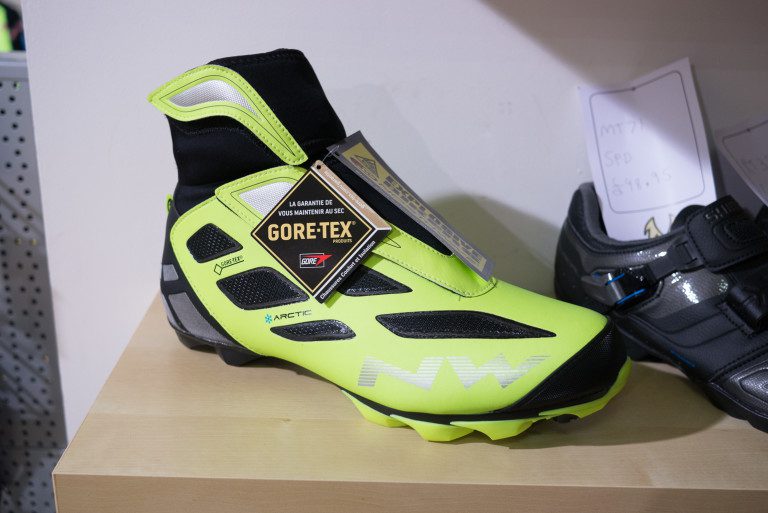
You can get MTB shoes with fully waterproofed uppers. These are usually high-ankle boots reserved for autumn-winter sloppy slogs.
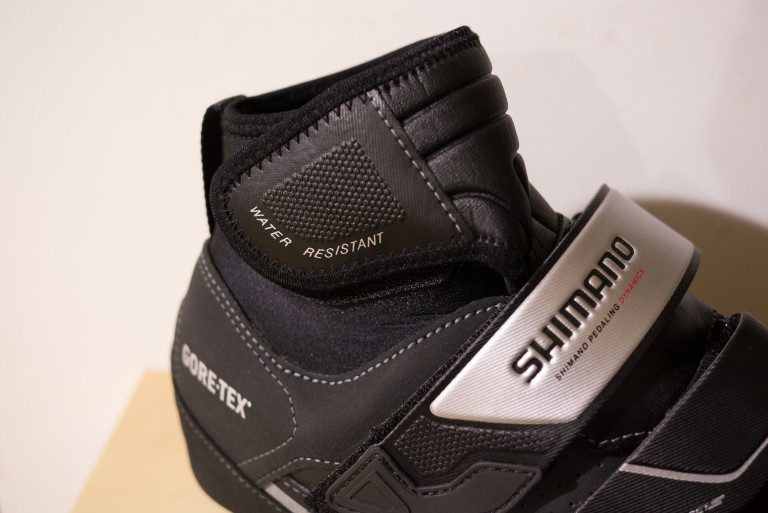
Obviously, water can still get in the top of footwear if you’re not careful so most of these designs come with snug-fitting Velcro closure wrap-overs too to prevent this. (Shimano)
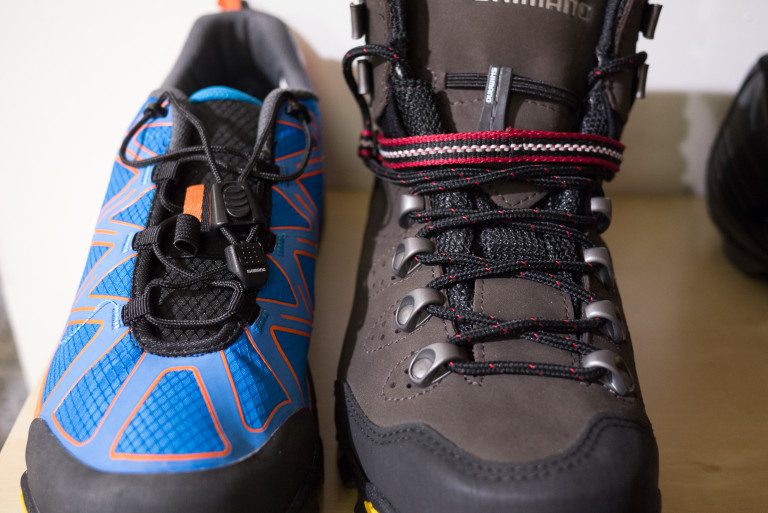
Fastening methods
You don’t find laces on many MTB shoes. There are some shoes that use them but they’re in the minority.
There are quite a few reasons why MTB shoes avoid laces. They’re hard to undo when covered in filth or when wet. There’s potential for them to get stuck in your drivetrain (ouch). They difficult to achieve and maintain a desired tension throughout the course of a ride.
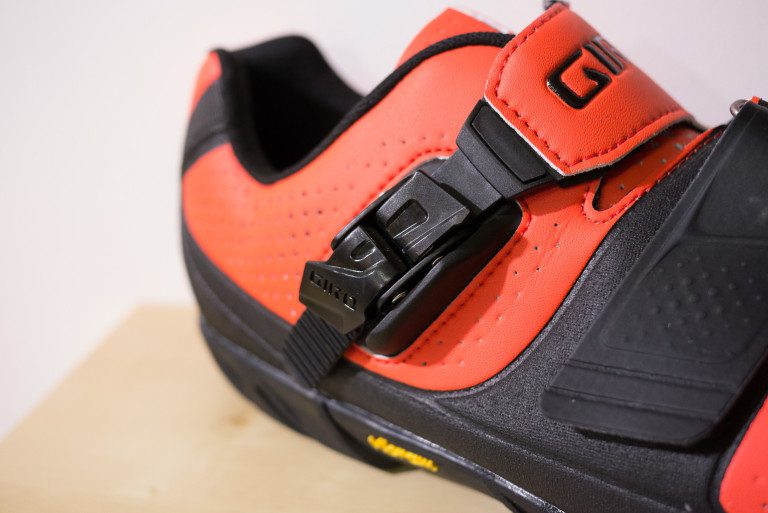
The most common fastening method on MTB shoes is straps. Usually two lower Velcro straps and a top strap with a tooth-and-ratchet design. This design offers a good combination of ease-of-use, all weather operation, adjustability, tension accuracy and consistency.
Other designs include the Boa lacing (one or two dials with a plastic wire threading itself around the lace bed). There are also shoes with just Velcro straps and shoes with a combination of laces with a top Velcro strap that also doubles as a lace tidy/holder.
Ankles
A small note about ankles. If you have dodgy ankles – or you’re always bashing your ankles on cranks or rocks – then you should contemplate getting high cut boot-style MTB shoes rather than low-cut ones.
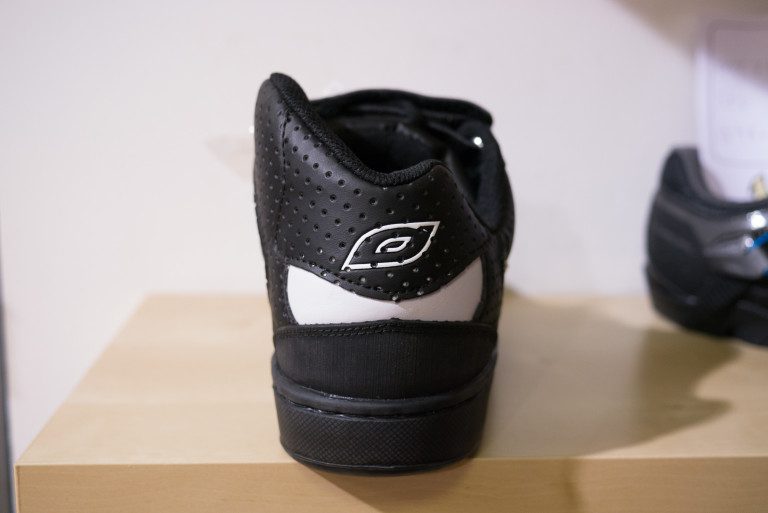
Sometimes it’s not obvious which shoes aren’t low cut so tkae your time to have a proper browse. Some shoes often only have the inner (crank) side of the shoe raised up significantly, which may be all you need for your riding.
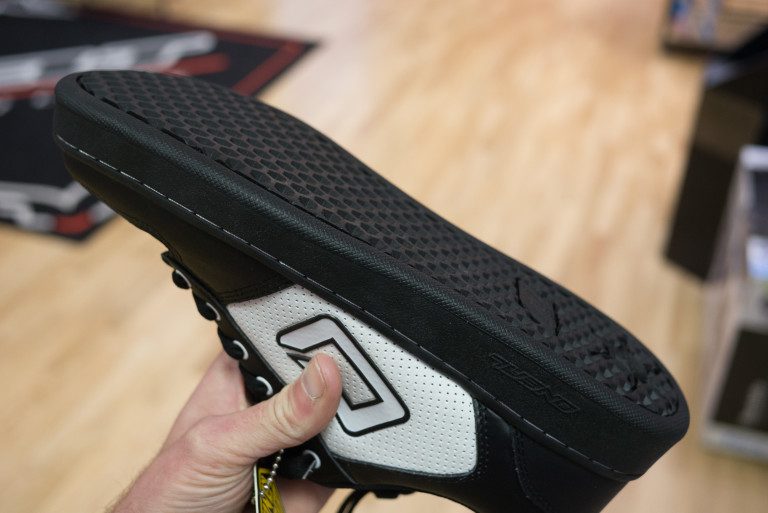
Shoes for flat pedals
For those of you using flat pedals – good for you. Flat pedals can do wonders for your skills, bike handling and, in a funny sort of way, how much fun you have when you’re out on a bike.
Anyway, what sort of shoes to get for flat pedals was recently covered in our buyers guide to flat pedals. So go and read that.
Which MTB shoes should you buy?
Leisure riders will either be fine using regular trainers if using flat pedals. But if you’re using clipless pedals then something like a touring or leisure cleat-compatible shoe will be ideal. Avoid stiff soles. Go for a shoe that looks ‘normal’ if you want to avoid the ‘serious cyclist’ look.
Regular riders are well served by the common shoe design of Velcro straps combined with a top ratchet strap. Avoid overly vented designs if you want an all-round shoe. Carbon soles are a bit OTT and may actually be undesirable on longer MTB rides with a stop-start nature etc.
Racers really should go for a heat moldable shoe with carbon sole, sleek uppers and capability of running a couple of toe studs. Stiff, light, comfy – but not cheap!
